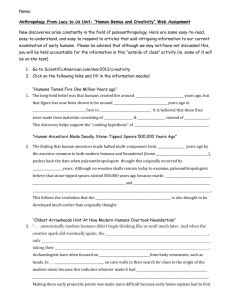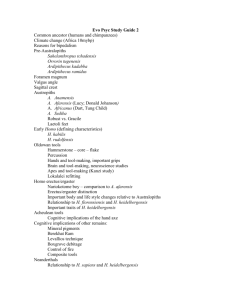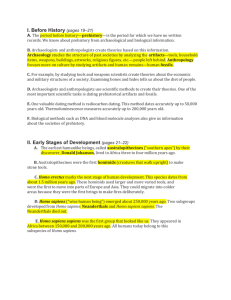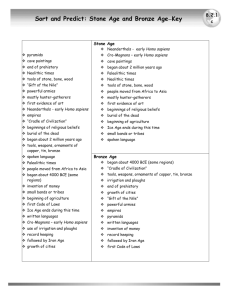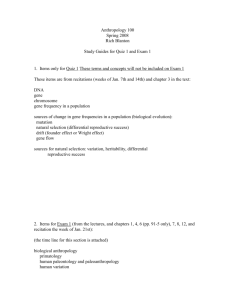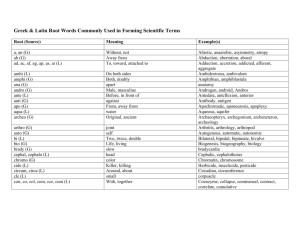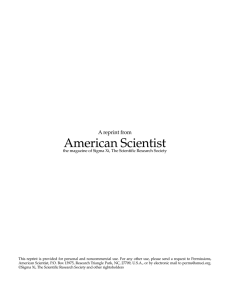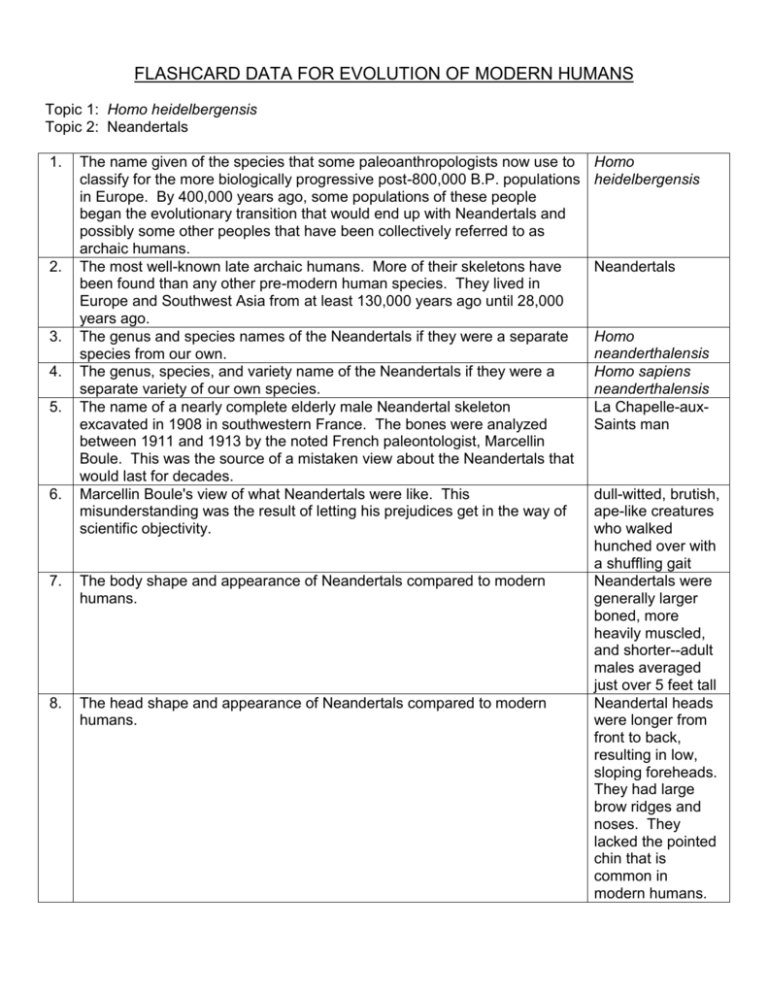
FLASHCARD DATA FOR EVOLUTION OF MODERN HUMANS
Topic 1: Homo heidelbergensis
Topic 2: Neandertals
1.
2.
3.
4.
5.
6.
The name given of the species that some paleoanthropologists now use to
classify for the more biologically progressive post-800,000 B.P. populations
in Europe. By 400,000 years ago, some populations of these people
began the evolutionary transition that would end up with Neandertals and
possibly some other peoples that have been collectively referred to as
archaic humans.
The most well-known late archaic humans. More of their skeletons have
been found than any other pre-modern human species. They lived in
Europe and Southwest Asia from at least 130,000 years ago until 28,000
years ago.
The genus and species names of the Neandertals if they were a separate
species from our own.
The genus, species, and variety name of the Neandertals if they were a
separate variety of our own species.
The name of a nearly complete elderly male Neandertal skeleton
excavated in 1908 in southwestern France. The bones were analyzed
between 1911 and 1913 by the noted French paleontologist, Marcellin
Boule. This was the source of a mistaken view about the Neandertals that
would last for decades.
Marcellin Boule's view of what Neandertals were like. This
misunderstanding was the result of letting his prejudices get in the way of
scientific objectivity.
7.
The body shape and appearance of Neandertals compared to modern
humans.
8.
The head shape and appearance of Neandertals compared to modern
humans.
Homo
heidelbergensis
Neandertals
Homo
neanderthalensis
Homo sapiens
neanderthalensis
La Chapelle-auxSaints man
dull-witted, brutish,
ape-like creatures
who walked
hunched over with
a shuffling gait
Neandertals were
generally larger
boned, more
heavily muscled,
and shorter--adult
males averaged
just over 5 feet tall
Neandertal heads
were longer from
front to back,
resulting in low,
sloping foreheads.
They had large
brow ridges and
noses. They
lacked the pointed
chin that is
common in
modern humans.
9.
The brain size of Neandertals relative to modern humans.
10. The kind of climate in which larger brains and bodies are metabolically
more efficient and likely to be selected for.
11. The term for a pattern of evolution in which different parts of the body
evolve at different rates. In the case of humans, we essentially attained
our modern form below the neck by at least 2 million years ago. However,
our cranial capacity did not reach its current size until around 100,000
years ago.
12. The term for the brain increasing in size over and beyond that explainable
by an increase in body size.
13. The first humans to live successfully in regions with sub-arctic climates.
Neandertal brains
were slightly larger
than those of the
average modern
human
(Neandertals
averaged 1450
c.c., modern
humans average
1345 c.c.)
very cold climate
mosaic evolution
encephalization
Neandertals
Topic 3: Archaic Human Culture
1.
2.
3.
4.
5.
6.
7.
8.
9.
The technical term for the “old stone” age.
The major tool traditions of the Lower Paleolithic stage of cultural
development. Tools of these traditions are found at Homo habilis and
Homo erectus sites.
The major tool tradition of the Middle Paleolithic stage of cultural
development. This tradition is most well known from Neandertal sites.
The things that Levallois technique were used to make. This technique
was first used in the late Acheulean Tradition by early archaic humans
about 250,000 years ago. It was perfected in the Mousterian Tradition by
the Neandertals and some of their contemporaries.
The first humans known to make stone tips for their spears.
A rust red iron ore that was ground to a powder state and used as a paint
pigment beginning with the Neandertals and early modern humans.
The name of a small area of the human brain that controls the production
of speech. It is located in the left frontal lobe of the cerebral cortex.
The kinds of animals that Neandertals apparently buried ritually in Western
European caves.
A French site where there is good evidence of early archaic humans
harnessing fire by 400,000 years ago. Many food refuse bones were found
charred presumably from cooking. In addition, there is possible evidence
of simple fire hearths that they made.
paleolithic
Oldowan and
Acheulean Tool
Traditions
Mousterian Tool
Tradition
standardized
flakes that were
used as preforms
to be made into a
variety of tools
Neandertals
hematite
Broca’s area
cave bears and
humans
Terra Amata
Topic 4: Early Modern Homo sapiens
1.
2.
3.
4.
5.
6.
7.
The biological genus, species, and variety to which every human today
belongs.
The general name given to the late ice age modern Homo sapiens who
appeared in Europe by 40,000 years ago. Their skeletons generally were
lighter than the Neandertals who occupied Europe at that time. They had
broad, small faces with pointed chins and high foreheads. They are the
ancestors of modern Europeans.
The part of the world where the oldest modern Homo sapiens have been
found.
The model of modern Homo sapiens origin that says that they evolved
more or less simultaneously in all major regions of the Old World from local
archaic human populations.
The model of modern Homo sapiens origin that says that they evolved
from archaic humans 200,000-100,000 years ago only in Africa and then
some of them migrated into the rest of the Old World replacing all of the
Neandertals and other late archaic humans.
The model of modern Homo sapiens origin that implies that all regional
anatomical differences that we see among humans today are recent
developments--evolving only in the last 50,000-40,000 years.
The general types of evidence that best support the replacement model of
modern Homo sapiens origin.
8.
The general type of evidence that best supports the regional continuity
model of modern Homo sapiens origin.
9. The model of modern Homo sapiens origin that is supported by the fact
that East Asians today commonly have shovel-shaped incisors while
Africans and Europeans rarely do. (Hint: Homo erectus also commonly
had this trait.)
10. The model of modern Homo sapiens origin that rejects both the complete
replacement and regional continuity models. (Hint: this new model
incorporates ideas from both of the old ones.)
11. The intercontinental land connection that appeared between Siberia and
Alaska as a result of sea levels dropping more than 300 feet during the last
ice age.
Homo sapiens
sapiens
Cro-Magnon
Africa
regional continuity
(or multiregional)
model
replacement (or
out of Africa)
model
replacement (or
out of Africa)
model
fossils and DNA
(especially
mitochondrial
DNA)
fossils
regional continuity
(or multiregional)
model
Assimilation ( or
partial
replacement)
model
Bering Plain or
Beringia
Topic 5: Early Modern Human Culture
1.
2.
The stage of the Paleolithic in which the advanced stone and bone tool
traditions of the Cro-Magnon and other late ice age modern humans
belong.
Spear hunting was revolutionized by the invention of this device that allows
a spear to be thrown farther. It was invented by at least 17,000-15,000
years ago.
Upper Paleolithic
spear thrower or
atlatl
3.
4.
5.
6.
7.
8.
9.
10.
11.
12.
13.
14.
A weapon that further increased the range of projectiles beyond that of
spears. It was invented by at least 12,000 years ago but took many
thousands of years to spread around the world.
Thin, roughly parallel-sided flakes of rock that are at least twice as long as
they are wide. Their cross-sections are usually either triangular or
trapezoidal. They were the basis of many Upper Paleolithic stone tool
forms—they were preforms for the manufacture of knives, hide scrapers,
spear tips, drills, awls, burins, etc.
A technique used to make Upper Paleolithic blade flakes. These nearly
standardized shapes were struck off of a prepared core by indirect
percussion using an antler tip and some sort of hammer to control the
direction and force of the shock wave entering the core.
A tool making technique in which a glass-like rock is struck with a heavy
glancing blow from another dense rock (a hammerstone) in order to cause
a flake to be removed. An artifact can be shaped by carefully and
systematically directing these blows with the hammerstone.
A tool making technique used in the Upper Paleolithic as a further
refinement in shaping glass-like rock artifacts. After preliminary shaping by
percussion flaking, a hard pointed object, like the tip of a deer antler, was
used in this method to literally push off flakes in the final shaping and
thinning process of a tool.
A narrow gouging chisel made from a blade flake. This tool was used by
Upper Paleolithic craftsmen to make, shape, and decoratively engrave
bone, tusk, and antler artifacts.
The general term for a tool that has multiple parts. When one part breaks,
it can be replaced rather than replacing the entire tool. Upper Paleolithic
tools that are in this category included detachable harpoon points and
interchangeable spear foreshafts of hard wood attached to spears.
Raw materials for tool making that came into much more common use in
the late Upper Paleolithic tool traditions. These materials had been used
occasionally in earlier tool traditions, but were only modified clumsily by
hammering, scraping, and burning. Among the Cro-Magnon people, they
progressively replaced wood and stone for many functions.
Small carvings of women that could fit into the hand made by the CroMagnon people. They usually were faceless idealized representations of
well fed and usually pregnant women with large buttocks. They were
made from 35,000 years ago down to the end of the last ice age 10,000
years ago.
What the Venus figurines made by the Cro-Magnon people are thought to
symbolize for those people.
The most well known thing found at the Cro-Magnon occupied cave sites
at Lascaux, France and Altamira, Spain.
The presumed function of the cave art produced by Cro-Magnon people.
This is based on the fact that the majority of the figures represented are
herd animals that they ate, many of which are shown either wounded or
pregnant. In addition the art was made in remote cave areas where few
people would encounter it.
bow and arrow
blade flakes
punch flaking
percussion flaking
pressure flaking
burin
compound tool
bone and antler
Venus figurines
female fertility and
health
extensive paintings
on the cave walls
sympathetic (or
imitative) hunting
and fertility magic
15. The specialized subsistence pattern based primarily on hunting large
animals, especially herbivorous herding mammals such as horses,
reindeer, bison, and elephants. This was the source of much of the food
consumed by late ice age people in the cold regions of the northern
hemisphere.
Copyright © 2005-2012 by Dennis O'Neil. All rights reserved.
big game hunting

